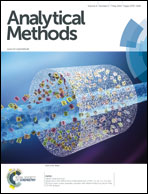Fabrication and application of a copper(ii)-selective extraction disc prepared from chlorinated polyvinyl chloride and ethylenediamine-functionalized cellulose
Abstract
Ethylenediamine-functionalized cellulose was prepared by the reaction of chlorinated cellulose and ethylenediamine. Next, the ethylenediamine-functionalized cellulose supported with copper(II) was prepared by the reaction of ethylenediamine-functionalized cellulose and CuCl2. The powdered product was mixed with a 1,2-dichloroethane solution of chlorinated polyvinyl chloride, and then cast into a film and decoppered. Finally, a copper(II)-selective extraction disc was obtained. Using the copper(II)-selective extraction disc for the spectrophotometric determination of Cu2+ in solution, the linear range for Cu2+ analysis was 40–1100 μmol L−1, and the detection limit was 38 μmol L−1 Cu2+. In the repeatability test for the analysis of 250 μmol L−1 CuCl2 solution using the copper(II)-selective extraction disc, the relative standard deviation of seven determinations was less than 4.3%. The levels of Cu2+ in porcine liver and wastewater were determined using this method. The determination results had no significant difference as compared with those by atomic absorption spectroscopy. However, the new method is more economical.


 Please wait while we load your content...
Please wait while we load your content...